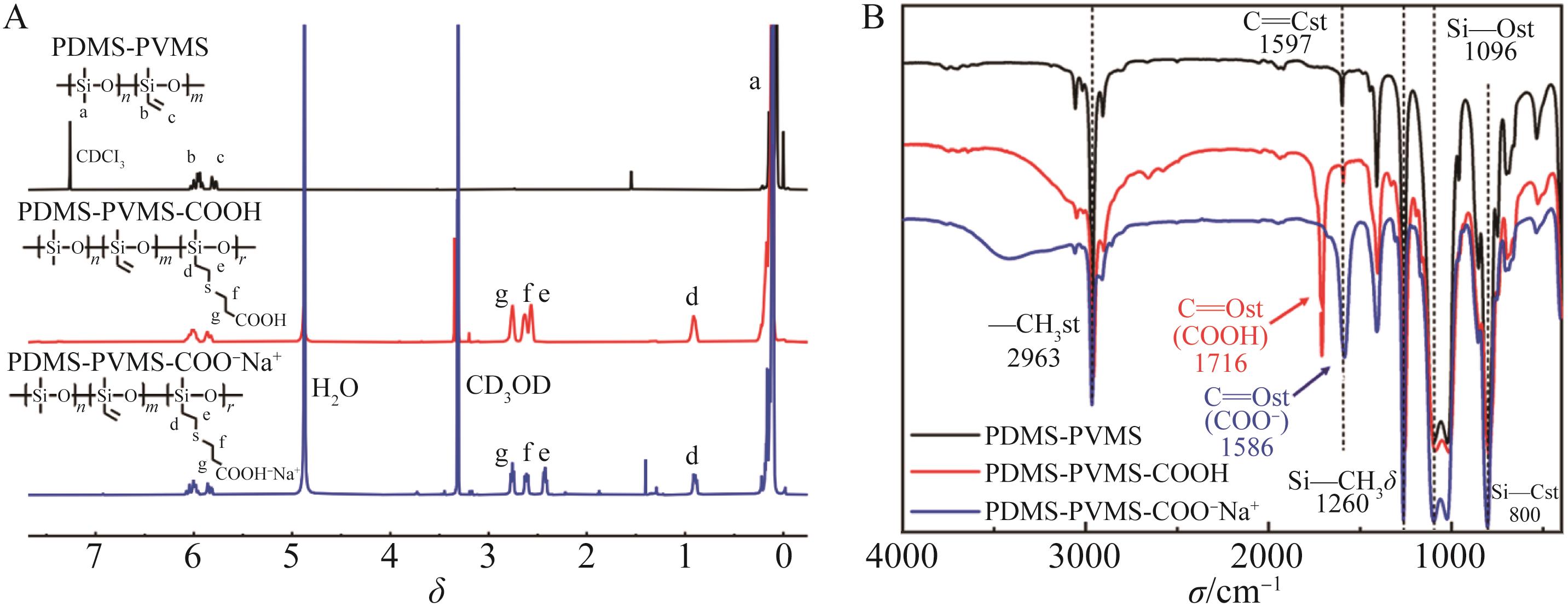
Chinese Journal of Applied Chemistry ›› 2022, Vol. 39 ›› Issue (8): 1224-1236.DOI: 10.19894/j.issn.1000-0518.210500
• Full Papers • Previous Articles Next Articles
Preparation and Properties Characterization of Hydrophilic Polysiloxane and Polyvinyl Alcohol Composite as Skin Barrier Material
Bing-Gang CHEN1,3, San-Rong LIU1, Zi-Jiang JIANG2( ), Xi-Fei YU1,3(
), Xi-Fei YU1,3( )
)
- 1.Laboratory of Polymer Composites Engineering,Changchun Institute of Applied Chemistry,Chinese Academy of Science,Changchun 130022,China
2.National Analytical Research Center of Electrochemistry and Spectroscopy,Changchun Institute of Applied Chemistry,Chinese Academy of Science,Changchun 130022,China
3.University of Science and Technology of China,Hefei 230026,China
-
Received:2021-10-15Accepted:2022-01-20Published:2022-08-01Online:2022-08-04 -
Contact:Xi-Fei YU -
About author:xfyu@ciac.ac.cn
-
Supported by:the National Natural Science Foundation of China Project(21674109)
CLC Number:
Cite this article
Bing-Gang CHEN, San-Rong LIU, Zi-Jiang JIANG, Xi-Fei YU. Preparation and Properties Characterization of Hydrophilic Polysiloxane and Polyvinyl Alcohol Composite as Skin Barrier Material[J]. Chinese Journal of Applied Chemistry, 2022, 39(8): 1224-1236.
share this article
Add to citation manager EndNote|Ris|BibTeX
URL: http://yyhx.ciac.jl.cn/EN/10.19894/j.issn.1000-0518.210500
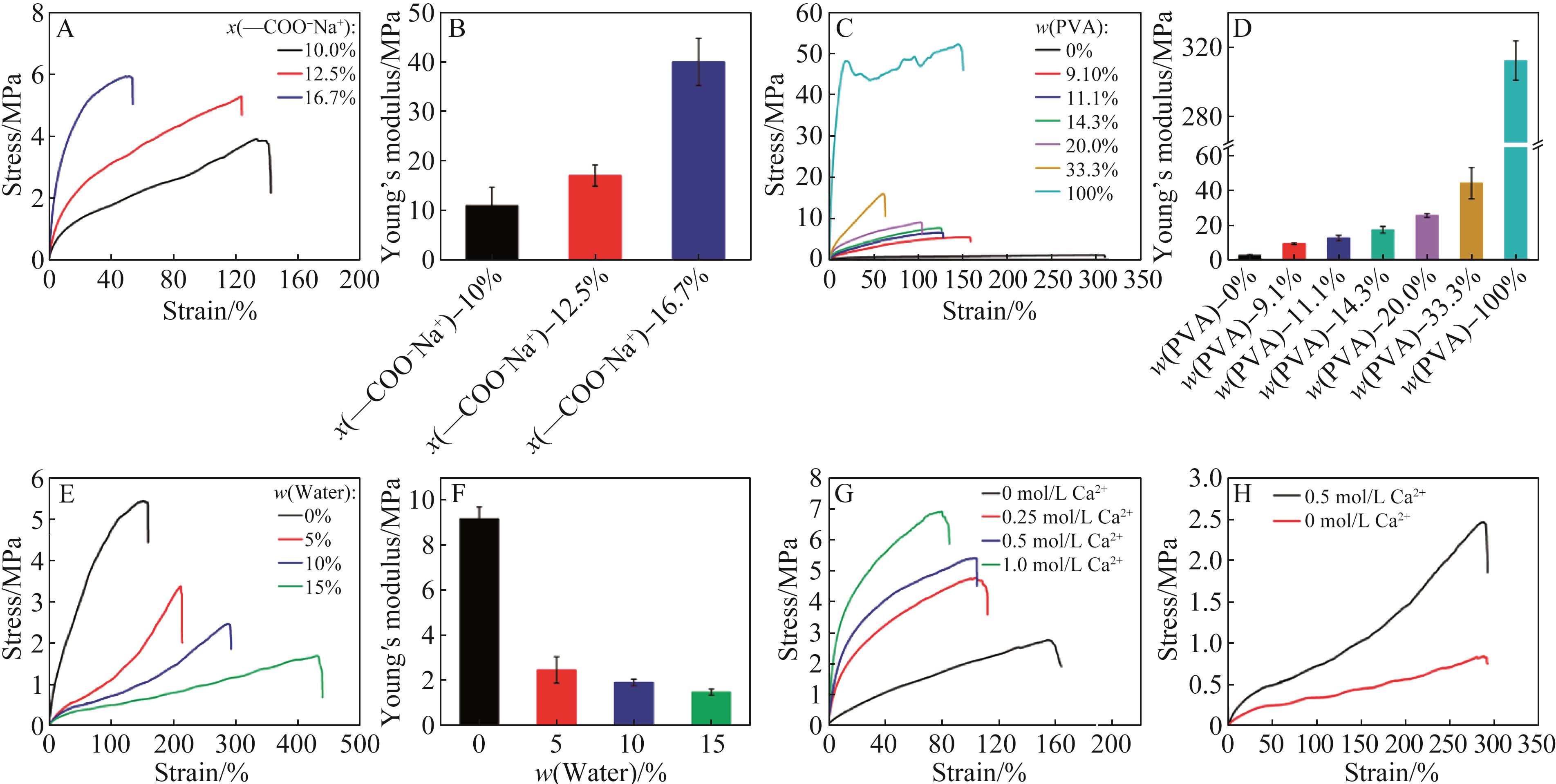
Fig.3 Mechanical properties: tensile curve (A) and Young's Modulus (B) of PSI-PVA film with different modified ratio of —COO-Na+ (PVA mass fraction was 9.10%, concentration of Ca2+ was 0.5 mol/L); tensile curve (C) and Young's Modulus (D) of PSI-PVA film with different mass fraction of PVA (—COO-Na+ mole fraction was 10%, concentration of Ca2+ was 0.5 mol/L); tensile curve (E) and Young′s Modulus (F) of PSI-PVA film with different content of water (—COO-Na+ mole fraction was 10%, PVA mass fraction was 9.10% and concentration of Ca2+ was 0.5 mol/L); (G) Tensile curve of PSI-PVA film with different concentration of Ca2+ (—COO-Na+ mole fraction was 10%, PVA mass fraction was 9.10% ); (H) Tensile curve of PSI-PVA film with or without Ca2+ crosslinking (—COO-Na+ mole fraction was 10%, PVA mass fraction was 9.10% and water content was 10%)
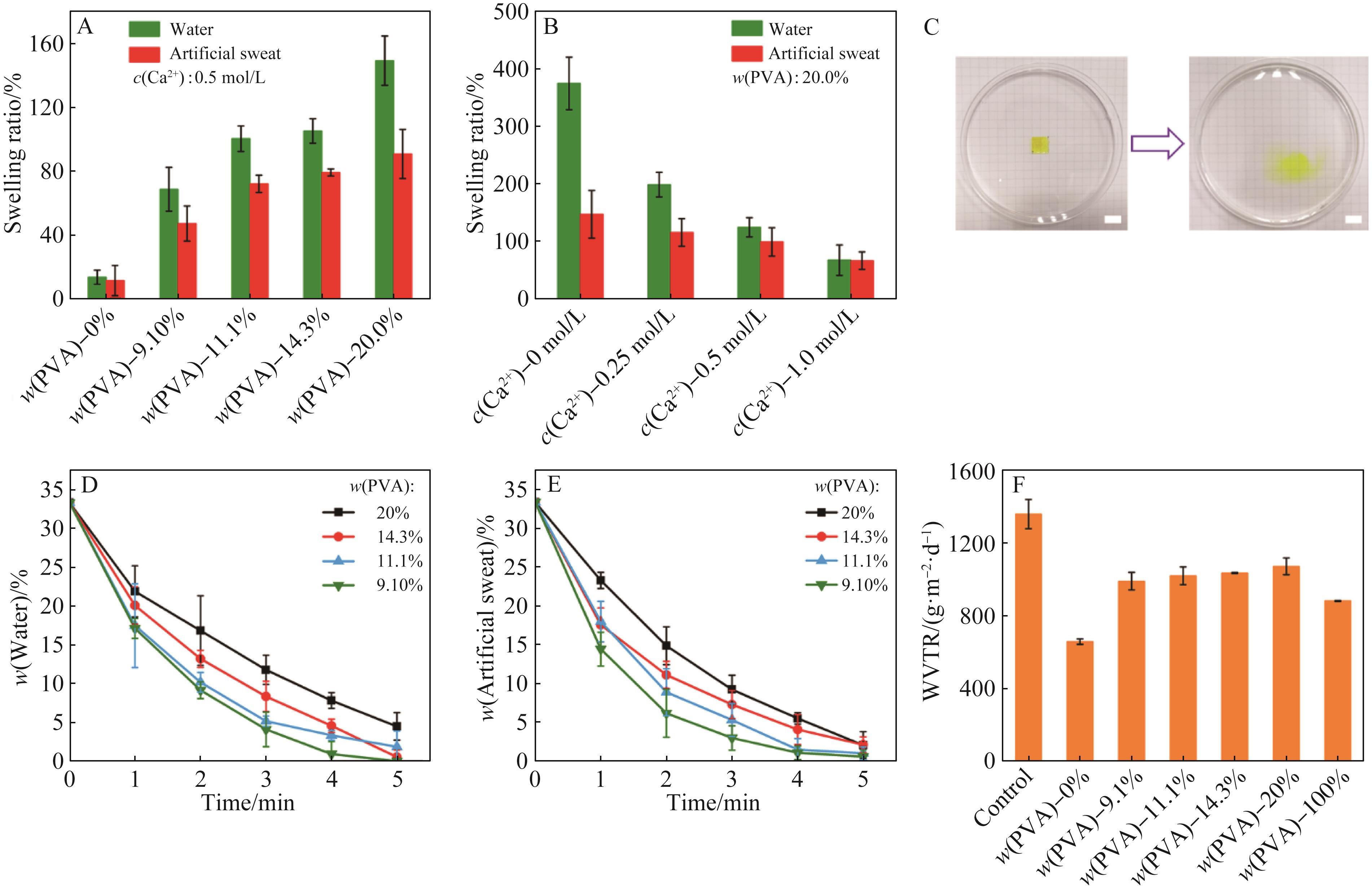
Fig.4 The swelling ratio of PSI-PVA film in water and artificial sweat with different PVA mass fraction (A) (concentration of Ca2+ was 0.5 mol/L), with different concentration of Ca2+ (B) (PVA mass fraction was 20%); (C) The photograph of PVA film in water (after dyeing, scale bar was 1 cm); The variation of water content with time of PSI-PVA film absorbing water (D) and artificial sweat (E) in room temperature (room temperature was 18 ℃ and relative humidity was 30%, concentration of Ca2+ was 0.5 mol/L); (F) The WVTR of PSI-PVA film with different mass fraction of PVA (concentration of Ca2+ was 0.5 mol/L)
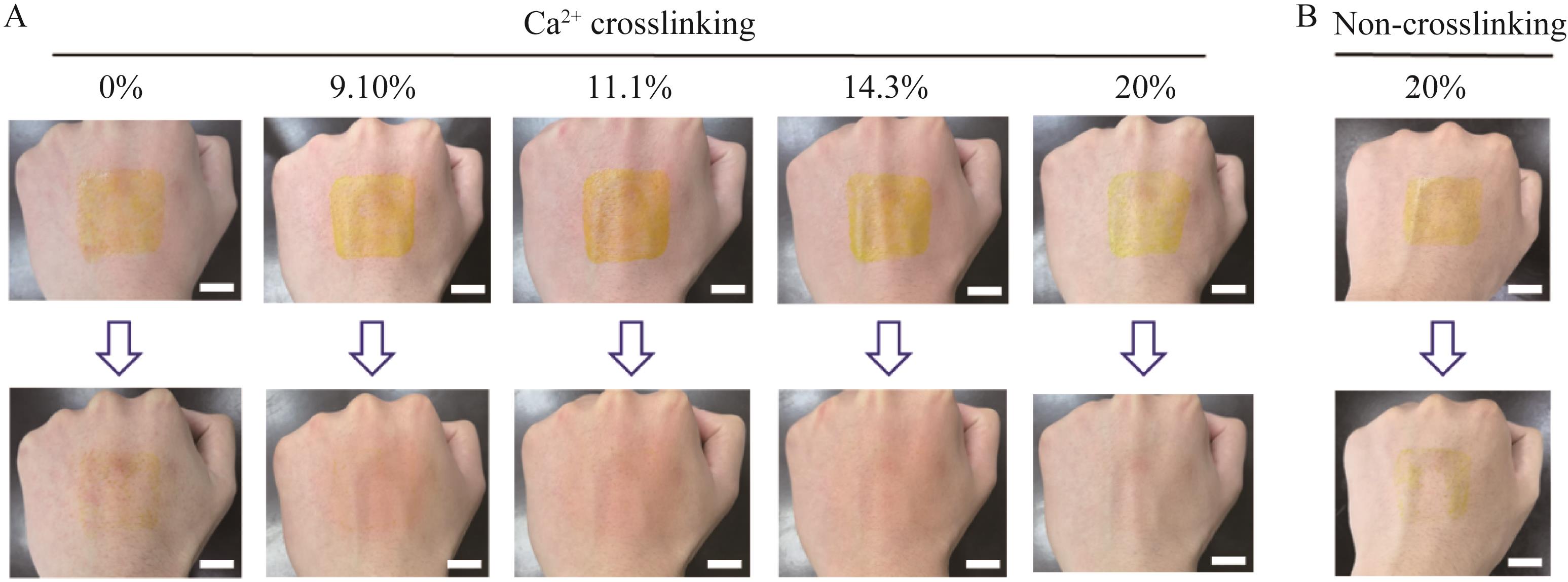
Fig.5 Cleaning properties: the cleaning situation of PSI-PVA film with different mass fraction of PVA after Ca2+ crosslinking (A), with PVA mass fraction of 20% after non-crosslinking (B) (the concentration of Ca2+ was 0.5 mol/L, scale bar was 1 cm)

Fig.6 The SEM morphology (A) and water contact angle (B) of PSI-PVA film with different mass fraction of PVA (the concentration of Ca2+ was 0.5 mol/L, scale bar was 50 μm)

Fig 7 (A) The UV absorbance of PSI in THF solution (0.5 mg/mL) with different mass fraction of UV-0; (B) The UV transmittance of PSI-PVA and PSI(UV)-PVA film (1.2 mg/cm2); the UV transmittance of PSI-PVA film (C) and PSI(UV)-PVA film (D) with different coating amount (PVA mass fraction was 9.10%, the concentration of Ca2+ was 0.5 mol/L)
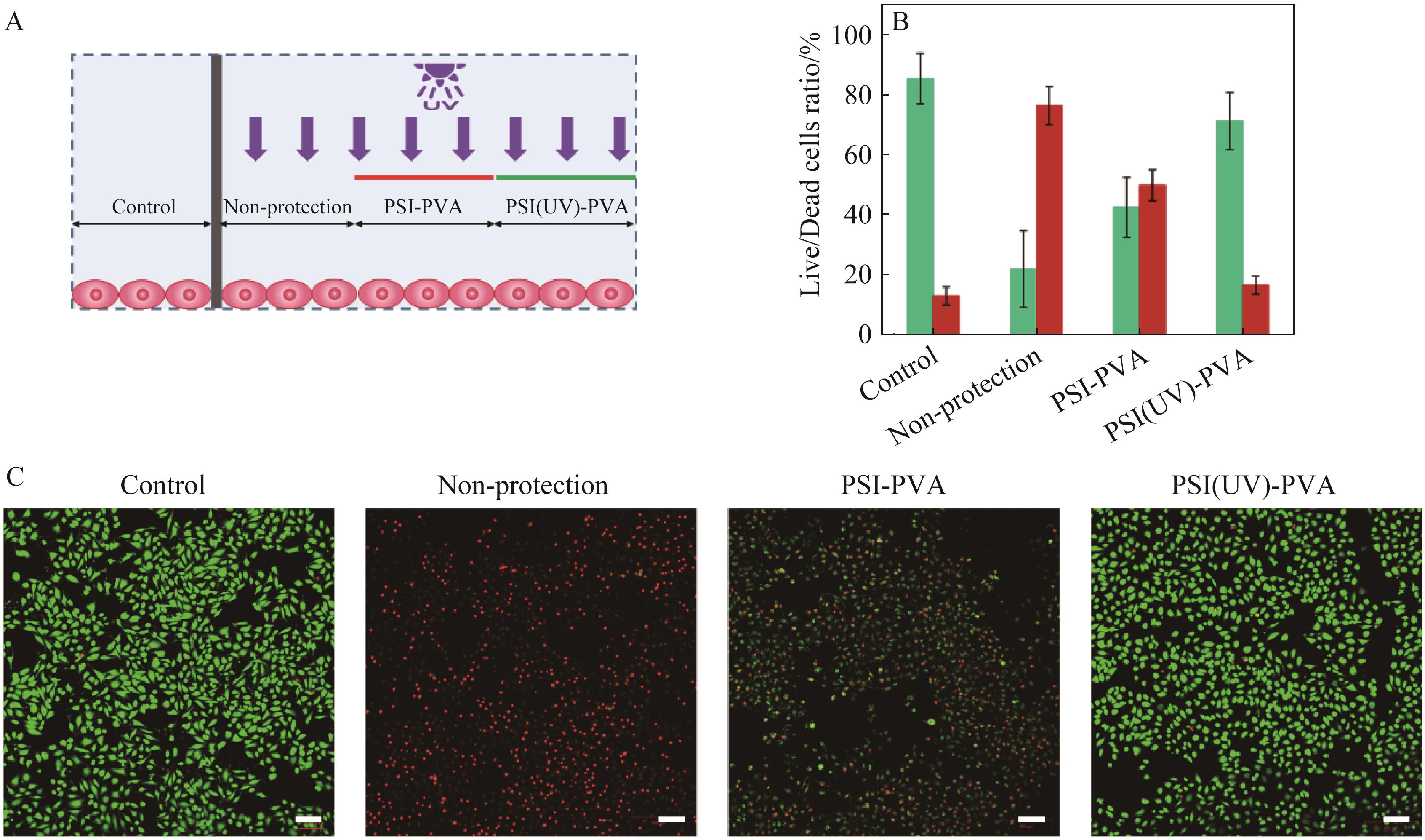
Fig.8 Anti-UV properties: (A) the schematic illustration of UV-shielding properties in vitro; the live/dead cell ratio (B) and live/dead stain images (C) of NIH 3T3 cell in different protected situations after UV irradiation (PVA mass fraction was 9.10%, the concentration of Ca2+ was 0.5 mol/L, scale bar was 100 μm)

Fig 9 Biocompatibility: (A) The cell viability of NIH 3T3 incubated for 24 h with different concentrations of PSI-PVA and PSI(UV)-PVA solutions; The live/dead stain images of NIH 3T3 cell incubated on different sample films for 24 h: (B) Control; (C) PSI-PVA film; (D) PSI(UV)-PVA film (PVA mass fraction was 9.10%, the concentration of Ca2+ was 0.5 mol/L, scale bar was 50 μm)
| 1 | SHERMAN V R, TANG Y, ZHAO S, et al. Structural characterization and viscoelastic constitutive modeling of skin[J]. Acta Biomater, 2017, 53: 460-469. |
| 2 | SHERMAN V R, YANG W, MEYERS M A, et al. The materials science of collagen[J]. J Mech Behav Biomed Mater, 2015, 52: 22-50. |
| 3 | PISSARENKO A, MEYERS M A. The materials science of skin: analysis, characterization, and modeling[J]. Prog Mater Sci, 2020, 110: 100634-100686. |
| 4 | SUN B K, SIPRASHVILI Z, KHAVARI P A. Advances in skin grafting and treatment of cutaneous wounds[J]. Science,2014, 346: 941-945. |
| 5 | SATO N, KITAHARA T, FUJIMURA T. Age-related changes of stratum corneum functions of skin on the trunk and the limbs[J]. Skin Pharmacol Physiol, 2014, 27: 181-187. |
| 6 | SHEIKHOLESLAM M, WRIGHT M E E, JESCHKE M G, et al. Biomaterials for skin substitutes[J]. Adv Healthc Mater, 2018, 7: 1700897-1700917. |
| 7 | ORYAN A, ALEMZADEH E, MOSHIRI A. Burn wound healing: present concepts, treatment strategies and future directions[J]. J Wound Care, 2017, 26: 5-19. |
| 8 | GIRARD D, LAVERDET B, BUHE V, et al. Biotechnological management of skin burn injuries: challenges and perspectives in wound healing and sensory recovery[J]. Tissue Eng Part B Rev, 2017, 23: 59-82. |
| 9 | BAKER L A, MARCHETTI B, KARSILI T N V, et al. Photoprotection: extending lessons learned from studying natural sunscreens to the design of artificial sunscreen constituents[J]. Chem Soc Rev, 2017, 46: 3770-3791. |
| 10 | D'ORAZIO J, JARRETT S, AMARO-ORTIZ A, et al. UV radiation and the skin[J]. Int J Mol Sci, 2013, 14: 12222-12248. |
| 11 | LAUTENSCHLAGER S, WULF H C, PITTELKOW M R. Photoprotection[J]. Lancet, 2007, 370: 528-537. |
| 12 | 王心蕊, 程慧敏, 唐丽萍, 等. 二维层状离子型纳米材料在化妆品领域的应用进展[J]. 应用化学, 2018, 35(10): 1166-1173. |
| WANG X R, CHENG H M, TANG L P, et al. Applications of two-dimensional layered nanomaterials in cosmetics[J]. Chinese J Appl Chem, 2018, 35(10): 1166-1173. | |
| 13 | SERPONE N, DONDI D, ALBINI A. Inorganic and organic UV filters: their role and efficacy in sunscreens and suncare products[J]. Inorg Chim Acta, 2007, 360: 794-802. |
| 14 | XING J, YUAN D, XIE H, et al. Preparation of efficient ultraviolet-protective transparent coating by using a titanium-containing hybrid oligomer[J]. ACS Appl Mater Interfaces, 2021, 13: 5592-5601. |
| 15 | YOO J, KIM H, CHANG H, et al. Biocompatible organosilica nanoparticles with self-encapsulated phenyl motifs for effective UV protection[J]. ACS Appl Mater Interfaces, 2020, 12: 9062-9069. |
| 16 | DONG Y, CHEN S, ZHOU S, et al. Perspectives on the next generation of sunscreen: safe, broadband, and long-term photostability[J]. ACS Mater Lett, 2019, 1: 336-343. |
| 17 | LOSANTOS R, FUNES-ARDOIZ I, AGUILERA J, et al. Rational design and synthesis of efficient sunscreens to boost the solar protection factor[J]. Angew Chem Int Ed, 2017, 56: 2632-2635. |
| 18 | YAMADA M, MOHAMMED Y, PROW T W. Advances and controversies in studying sunscreen delivery and toxicity[J]. Adv Drug Deliv Rev, 2020, 153: 72-86. |
| 19 | ADAMSON A S, SHINKAI K. Systemic absorption of sunscreen: balancing benefits with unknown harms[J]. JAMA, 2020, 323: 223-224. |
| 20 | WU C, HUANG J, CHU B, et al. Dynamic and hierarchically structured networks with tissue-like mechanical behavior[J]. ACS Nano, 2019, 13: 10727-10736. |
| 21 | YU B, KANG S Y, AKTHAKUL A, et al. An elastic second skin[J]. Nat Mater 2016, 15: 911-918. |
| 22 | BORDE A, LARSSON M, ODELBERG Y, et al. Increased water transport in PDMS silicone films by addition of excipients[J]. Acta Biomater, 2012, 8: 579-588. |
| 23 | BEZUIDENHOUT D, WILLIAMS D F, ZILLA P. Polymeric heart valves for surgical implantation, catheter-based technologies and heart assist devices[J]. Biomaterials, 2015, 36: 6-25. |
| 24 | HAO X, JEFFERY J L, WILKIE J S, et al. Functionalised polysiloxanes as injectable, in situ curable accommodating intraocular lenses[J]. Biomaterials, 2010, 31: 8153-8163. |
| 25 | KUMAR A, HAN S S. PVA-based hydrogels for tissue engineering: a review[J]. Int J Polym Mater Polym Biomater, 2016, 66: 159-182. |
| 26 | CAZÓN P, VELÁZQUEZ G, VÁZQUEZ M. Characterization of bacterial cellulose films combined with chitosan and polyvinyl alcohol: evaluation of mechanical and barrier properties[J]. Carbohydr Polym, 2019, 216: 72-85. |
| 27 | TEIXEIRA M A, AMORIM M T P, FELGUEIRAS H P. Poly(vinyl alcohol)-based nanofibrous electrospun scaffolds for tissue engineering applications[J]. Polymers, 2019, 12: 1-33. |
| 28 | 刘艳, 俞丹, 李维亚, 等. 壳聚糖-聚乙烯醇共混膜在织物化学镀中的应用[J]. 应用化学, 2015, 32(2): 200-206. |
| LIU Y, YU D, LI W Y, et al. Application of chitosan/polyvinyl alcohol complex film in fabrics' electroless plating[J]. Chinese J Appl Chem, 2015, 32(2): 200-206. | |
| 29 | HUANG Y, GUO M, TAN J, et al. Impact of molecular architecture on surface properties and aqueous stabilities of silicone-based carboxylate surfactants[J]. Langmuir, 2020, 36: 2023-2029. |
| 30 | WANG R, WANG X, ZHAN Y, et al. A dual network hydrogel sunscreen based on poly-gamma-glutamic acid/tannic acid demonstrates excellent anti-UV, self-recovery, and skin-integration capacities[J]. ACS Appl Mater Interfaces, 2019, 11: 37502-37512. |
| 31 | JIJI S, UDHAYAKUMAR S, MAHARAJAN K, et al. Bacterial cellulose matrix with in situ impregnation of silver nanoparticles via catecholic redox chemistry for third degree burn wound healing[J]. Carbohydr Polym, 2020, 245: 116573. |
| 32 | SOBHANIAN P, KHORRAM M, HASHEMI S S, et al. Development of nanofibrous collagen-grafted poly(vinyl alcohol)/gelatin/alginate scaffolds as potential skin substitute[J]. Int J Biol Macromol, 2019, 130: 977-987. |
| [1] | Li-Juan YAN, Tian-He GAO, Dong-Jian SHI, Ming-Qing CHEN. Preparation and Properties of Eugenol/Modified Polyvinyl Alcohol Antibacterial Composite Films [J]. Chinese Journal of Applied Chemistry, 2023, 40(4): 527-535. |
| [2] | SUN Qi, WANG Liqiu, LIU Yang, GUO Chenxiao, WANG Pengjun, LIU Xuelong, ZHANG Xiaobo, ZHENG Lihui, LIU Liping. Preparation and Properties of Near Infrared Polyvinyl Alcohol Fluorescent Polymer Materials [J]. Chinese Journal of Applied Chemistry, 2018, 35(1): 53-59. |
| [3] | LIU Yan, YU Dan, LI Weiya, GAO Cuicui, WANG Wei. Application of Chitosan/Polyvinyl Alcohol Complex Film in Fabrics' Electroless Plating [J]. Chinese Journal of Applied Chemistry, 2015, 32(2): 200-206. |
| [4] | DENG Xinwang, HU Huiyuan, LUO Zhongkuan, WU Maosheng, ZHOU Li. Preparation and Properties of Heparin Sodium/Polyvinyl Alcohol Composite Hydrogel [J]. Chinese Journal of Applied Chemistry, 2015, 32(12): 1358-1363. |
| [5] | FAN Zhiheng, ZHOU Li*, OUYANG Junjun, LUO Zhongkuan, LI Miaomiao. Preparation and Performance of Polyvinyl Alcohol/Chitosan/Nano-hydroxyapatite Composite Hydrogel via a Chem-physical Method [J]. Chinese Journal of Applied Chemistry, 2014, 31(01): 61-64. |
| [6] | YE Wenbo1,2, HUANG Shijun1,2, GUAN Huaimin1,2, TONG Yuejin2,3*. Preparation and Propoties of the Superhydrophobic Polysiloxane Coatings [J]. Chinese Journal of Applied Chemistry, 2012, 29(10): 1123-1129. |
| [7] | OUYANG Junjun,ZHOU Li*. Preparation and Properties of Porous β-Tricalcium Phosphate/Chitosan/Polyvinyl Alcohol Composite Hydrogel [J]. Chinese Journal of Applied Chemistry, 2012, 29(09): 995-999. |
| [8] | HE Yuxin, ZHANG Yuqing. Thermoplastic Starch/Polyvinyl Alcohol/Montmorillonite Nanocomposites [J]. Chinese Journal of Applied Chemistry, 2011, 28(07): 764-769. |
| [9] | ZHAO Shuixia, WANG Lailai*. Synthesis of Organosilixane Prepolymer and Their Application in Chemical Sand-fixing [J]. Chinese Journal of Applied Chemistry, 2011, 28(07): 753-758. |
| [10] | HUANG Qiong-Yu, ZHANG Ming-Xia, LIU Fang, XIAO Xiu-Feng, LIU Rong-Fang*. Preparation and Performance of Chitosan-Polyvinyl Alcohol-sodium Tripolyphosphate Complex Microparticles [J]. Chinese Journal of Applied Chemistry, 2010, 27(01): 21-26. |
| [11] | SUN Xi-Jun, YAO Jin-Shui*, ZHAO Yan. Preparation and evaluation of chiral stationary phase through grafting to polysiloxane [J]. Chinese Journal of Applied Chemistry, 2009, 26(12): 1395-1398. |
| [12] | Wang Yongxian . Synthesis of Polysiloxane-polyacrylate IPN Coating [J]. Chinese Journal of Applied Chemistry, 1997, 0(4): 33-36. |
| [13] | He Weidong, Cao Chuntao, Pan Caiyuan, Feng Jianping. Determination of the Reactivity Ratios of Copolymerization between Vinyl-containing Polysiloxane and Vinyl Monomers and the Influence on the Morphology of Composite Particles [J]. Chinese Journal of Applied Chemistry, 1996, 0(6): 15-18. |
| [14] | Sun Wenbo, Xie Hongquan. Synthesis and Characterization of Polysiloxane Copolymer with Uniform Polyoxyethylene Grafts [J]. Chinese Journal of Applied Chemistry, 1996, 0(1): 26-29. |
| [15] | Chen Li, Huang Ying. Modification of Epoxy Molding Compounds with Epoxy-terminated Polydimethylsiloxane [J]. Chinese Journal of Applied Chemistry, 1995, 0(5): 67-72. |
| Viewed | ||||||
|
Full text |
|
|||||
|
Abstract |
|
|||||

